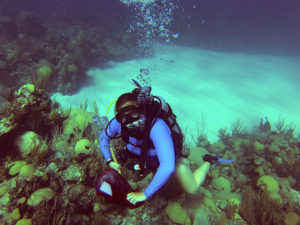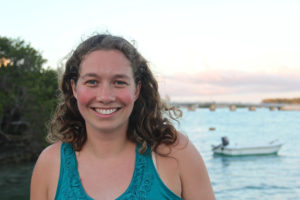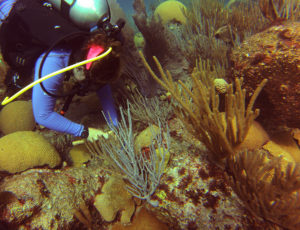
No one would ever guess that Hannah Reich ’15 was once nervous about scuba diving. How could you? As an undergrad, Reich spent four years on the Clark University swim team, and she grew up enjoying frequent visits to New England’s shores.
Reich’s passion was sparked when she spent the fall 2013 semester abroad in the Turks and Caicos Islands at the School for Field Studies. While researching coral bleaching, her interest in reef conservation bloomed, and she became hooked on studying the delicate symbiotic relationship between coral and algae.
“Corals are animals that secrete limestone structures,” she says. “Corals also have a symbiotic relationship with algae from the genus Symbiodinium to provide the coral with energy. The Symbiodinium photosynthesize, transforming energy from sunlight, into energy for the host coral. In return the algal gets protection from UV radiation.”

This relationship gives coral the vaulted status of being tropical marine ecosystem engineers. Degradation of coral reef ecosystems can severely impact everything from fish populations to sediment stabilization. The corals’ ability to secrete limestone structures essentially builds the tropical marine ecosystem, she says. “Corals receive the energy to build these limestone structures from their algal symbionts,” Reich says. “That’s one of the many reasons the algal symbionts are so important.” Corals are small but mighty ocean residents. “It’s amazing that something that covers less than one percent of the ocean floor could be a habitat structure for more than 25 percent of marine fish.”
To reach the coral, Reich needed to learn how to scuba dive, a prospect she initially found terrifying. Before heading to the Caribbean, she earned her scuba certification for shallow dives and would later discover the stark difference between diving in a murky New England lake and clear tropical waters.
“My first dive to 100 feet in the Turks and Caicos was one of my favorite dives,” says the Massachusetts native. “In South Caicos, at 100 feet, the wall drops off and plummets into the open ocean.”
In summer 2014, Reich traveled to the Bermuda Institute of Ocean Sciences (BIOS) to attend the Coral Reef Ecology course and learn from the community of researchers who are devoted to oceanic studies. “I thrive on the energy at BIOS, fueled by the scientists’ passion for advancing research in marine sciences,” she says.

This past summer, Reich returned to BIOS to conduct the fieldwork for her master’s thesis under the direction of Dr. Gretchen Goodbody-Gringley, assistant scientist at BIOS, who invited her to work in her lab. Reich’s work in Bermuda is the first marine research partnership with BIOS faculty in the long-standing relationship between Clark University and BIOS, begun in the early 1960s when legendary Clark biology professor Rudolph “Rudy” Nunnemacher began taking students to Bermuda on research excursions.
Reich is studying juvenile corals from both shallow (30-foot) and deep (100-foot) reefs. She is interested in any differences between spawning synchronies, juvenile settlement rates, and juvenile growth rates. In addition, Reich is interested in how the composition of the coral’s algal symbionts change with development, with depth, and when the juveniles are transplanted to different depths.
While at BIOS, Reich continued her research as she monitored coral spawning and juvenile coral settlement. Once settled, she and her collaborators transplanted the juveniles to shallow and mesophotic waters where corals that depend on light are found with species that survive with a lower light environment. Then Reich transplanted the juvenile corals to shallow and deep waters.
She notes that her work has been funded by a Clark University Geller Award, a BIOS Grant-In-Aid, the BIOS education department, and a PADI Foundation grant.
In Clark’s labs, Reich, now a graduate student in biology, continuing her studies from dry land. She is currently investigating the algal symbionts inside the corals across a depth gradient and how difference in depth could play a role in juvenile coral survivorship. She’s examining DNA sequences to determine the species and sub-species composition.
“My passion for studying coral-algal symbiosis and response to climate change are still relatively new and are evolving,” says Reich. “I’m eager to see where my graduate research takes me.”


